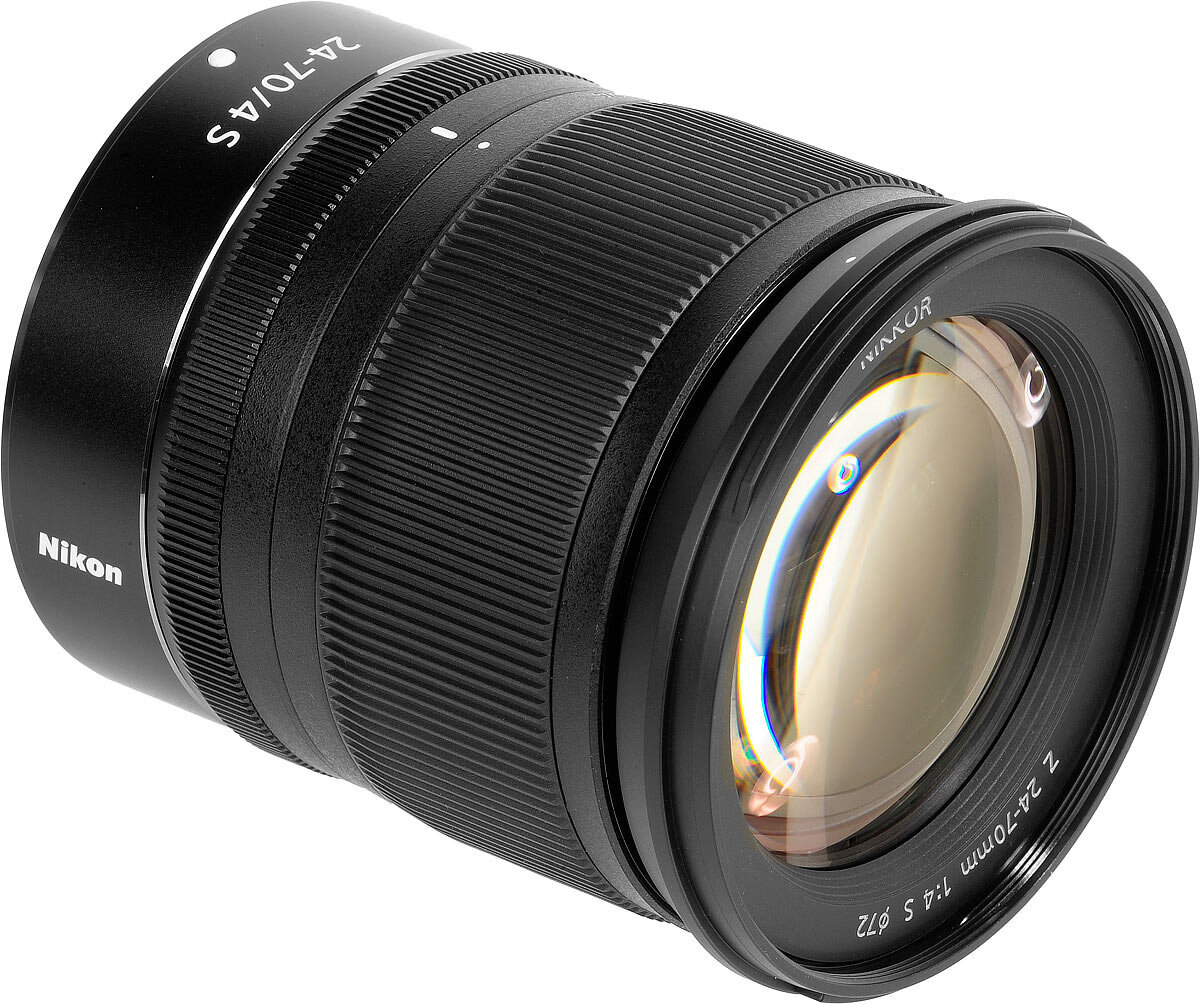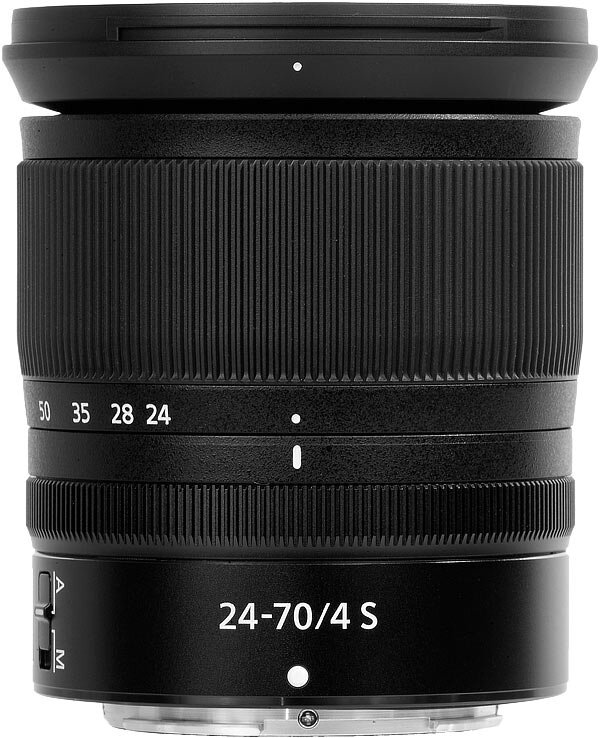The Nikon Z 24-70 f/4 S Lens
Nikon Nikkor Z 24-70mm f/4 S lens
The Nikon Z 24-70 f/4 S lens was one of the first Z-mount lenses released by Nikon and was often supplied as part of a kit with the Z6 and Z7 cameras, however this lens is part of Nikon’s S-Line meaning it is much more than a standard cheap kit lens. The lens is perfectly balanced on the Z6 camera offering a small and lightweight setup.
Build and Ergonomics:
The Z 24-70 f/4 S doesn’t win any prizes for its cosmetic appeal, looking like a fairly bland lens with very little to identify it as a high spec objective. Nikon has lost the gold accents and plethora of switches normally found on its F-mount lenses and moved towards a simple black with white text colour scheme with only the silver Nikkor S label to identify it as a high spec lens. Nikon’s S-Line lenses offer superior resolution and edge to edge sharpness, nano crystal coatings and other technologies to optimise optical performance for the Z cameras.
The lens is a mixture of polycarbonate and metal construction but even though most of the outer surfaces are plastic they do seem to have a high quality feel to them and there is a bit of heft to the lens.
The lens has two ribbed rings, one to zoom and the second a control ring. Both turn smoothly with no indication of sticking or binding. The zoom ring is about 4cm wide and covered in rubber whereas the control ring is much narrower and plastic so it is easy to distinguish between the two by touch alone.
The control ring function defaults to focus adjustment, but as this is an electronic control by wire ring its function can be customised in the camera body (Custom Settings > f.Controls > f2 Custom controls assignment) to offer aperture control, exposure compensation, ISO setting or disabled.
Other than the two barrel rings the only other control is the A / M switch on the side of the barrel to switch between Auto and Manual focus. It should be noted that the lens control ring automatically switches back to focus whenever you switch the A / M switch to manual.
Large zoom ring at top (nearest lens front) and narrower control ring closest to camera (between zoom scale and lens designation). Note the A/M switch on the left side of the lens barrel.
The lens is small and light, weighing approximately 500g, 7.8 cm diameter and only 8.8 cm long when closed. Nikon have used a locking mechanism to retract the lens when not in use to achieve this small size, but when locked the camera will not take photos and presents a message instructing you to unlock the lens before use. Unlocking is a simple twist of the moon ring (clockwise when looking from the camera side) but this is quite stiff and the first time you use the lens you might think it had jammed!
A lot of reports and reviews on the internet complain about the need to unlock the lens before it can be used. Once unlocked, however, the lens can be left extended if you need to be able to shoot quickly, without having to retract then extend again. With the lens at 24mm and held vertically there is no sign of any creep - you just need to be careful you don’t bang the end of the lens! Once you’ve finished shooting retract the lens into its locked position and it minimises the space required for storage.
The lens barrel telescopes in and out as the lens is zoomed through its 24 - 70mm range. The barrel has two extending sections (in addition to the main lens body) that telescope within each other over the zoom range. When both are fully extended there is no noticeable wobble between the sections that is often evident on lower quality zooms.
Nikkor Z 24-70 f/4 S lens showing relative length over zoom range
Left - 8.8cm when retracted into locked position, Centre: 11cm at 24mm, Right: 15cm at 70mm
The barrel sections are also fully waterproofed and weather sealed and I have used the lens in relatively heavy rain with no signs of water ingress. The front element is also coated with a fluorine coat to repel moisture, grease and dirt, making it easier to keep the lens clean.
The front of the lens is fitted with a 72mm plastic filter thread unlike most other Nikon lenses that take 67mm or 77mm filters. I have fitted a Breakthrough X4 brass 72-77mm step up ring to allow the use of my existing 77mm filters but there is an issue with fitting the lens hood with the ring. The step up ring can be screwed onto the front of the lens with the hood in place but the hood cannot then be removed without first taking the step up ring off. The hood is quite small though so it is relatively easy to fit filters and remove the ring as necessary (particularly as the Breakthrough X4 has a ribbed edge to make it easy to grip). Having said that, I tend to leave the hood and ring in place all of the time and use a spare 77mm lens cap from one of my F-mount lenses.
Vibration Reduction:
The lens does not have any in-built vibration reduction, instead relying on the In Body Image Stabilisation (IBIS) of the Z series cameras. The IBIS offers full 5 axis (pitch, roll, yaw, horizontal and vertical) image stabilisation with this lens and is claimed to provide up to 5 stops of correction. I have been regularly obtaining sharp shots at 70mm and between 1/4 and 1/8 second without the need for camera support (between 3 and 4 stops) with no indication of camera shake when viewed at 200% zoom. This is significantly better than I used to achieve with the F-mount equivalent VR, possibly due to the differences in size and weight as much as the performance of the image stabilisation. As such, I am more likely to try handholding the camera for landscape shots more than using a tripod.
Focus:
The lens autofocuses very quickly and accurately and is almost silent. Previously I have used F-mount lenses and there is a tendency for them to chatter when adjusting focus in AF-C mode. This lens does not have the same issue, ideal for video shooters as the microphone would pick up this noise.
I have not performed extensive testing of the lens but the autofocus performance on a Lens Align test chart shows very accurate and reproducible results. The lens focus was spot on and repeatability was very good.
The lens can be switched into manual focus using the switch on the side of the lens barrel or via the menu system in the camera. Manual focus of the lens uses a configurable “fly-by-wire” control ring that is speed sensitive, so the faster you turn the lens ring the more it moves focus. Once in manual focus mode tis control ring switches to a focus ring no matter what custom setting has been selected in the camera body. There is a little lag between starting to turn the ring and the lens focus responding, almost as if the lens is checking that you didn’t move it by accident before it starts to respond. There are no focus marks on the lens so it is not possible to tell the distance the lens is focussed to, making it difficult to pull focus for video shooting and impossible to set to the hyperlocal distance for example.
The lens also has a manual override for autofocus, so for example, if the control ring is set to its default value of manual focus, you can turn the focus ring while in autofocus mode with the shutter half pressed (or the AF-ON button pressed) to fine tune the focus, including using the rangefinder and focus peaking options in the viewfinder.
Image Quality:
The image quality from this lens is outstanding at all focal lengths. Wide open at f/4 the lens is very sharp across the whole frame, although slightly softer at the corners. Stopping down to f/5.6 or f/8 increases the sharpness. At f/16 the images start to lose some crispness due to the effects of diffraction. The lens performance is significantly sharper than the F-mount AF-S 24-70 f/2.8G that I use with my D850.
The lens shows no signs of vignetting or distortion due to the built in lens correction profile applied in the camera and carried across into programs such as Adobe Lightroom Classic. If you use other software that doesn’t support these built in profiles then there is some small barrel distortion at the wide end and pin cushion distortion at the telephoto end of the zoom range. Between about 35mm and 55mm focal length distortion is non-existent.
I tend to pre-process my images using DXO PureRAW which provides an independent correction for distortion, sharpness, and vignetting and find that these corrections are noticeably improved compared to the Nikon built in profiles. Comparison of the DXO corrected image compared to the built in profile image in Lightroom, for example, shows better distortion control and less vignetting on the DXO image.
The lens appears to be well protected against flare when shooting into the sun, with very little to no flare spots noticeable on my images.
Wasdale in the Lake District shows good edge to edge sharpness
Z 24-70 f/4 S at 58mm on Nikon Z6 at f/8, 1/160th second at ISO 100 unedited exported from Lightroom
Crummock Water in the Lake District shows no evidence of vignetting at 24mm
Z 24-70 f/4 S at 24mm on Nikon Z6 at f/8, 1/320th second at ISO 100 unedited exported from Lightroom
Crummock Water in the Lake District shows no evidence of flare shooting towards the sun at 24mm
Z 24-70 f/4 S at 24mm on Nikon Z6 at f/8, 1/400th second at ISO 100 unedited exported from Lightroom
The Technical Bits:
Mount Type: Nikon Z Mount
Focal Length Range: 24-70mm
Aperture Range: f/4 to f/22
Aperture Blades: 7 (rounded)
Filter Size: 72mm
Lens Elements: 14
Lens Groups: 11
Special Elements: 3 Aspherical, 1 ED, 1 Aspherical ED
Fluorine Coating: Yes
Nano Crystal Coating: Yes
Super Integrated Coating: Yes
Electronic Diaphragm: Yes
Focus Motor: AF-P Stepper Motor (STM)
Internal Focusing: Yes
Internal Zooming: No
Minimum Focus Distance: 0.3 meters (0.99 feet)
Maximum Reproduction Ratio: 1:3.33, or 0.3x Magnification
Weather/Dust Sealing: Yes
Mount Material: Metal
Dimensions: 77.5 x 88.5 mm (3.1 x 3.5 inches)
Weight: 500 g (17.7 oz)
Angle of View: 84° (at 24mm) to 34°20′ (at 70mm)
Conclusion:
Nikon has created a very impressive lens with the Z 24-70mm f/4 S. Its performance, especially sharpness, is unexpectedly good. Its compact size and low weight perfectly suit the Nikon Z6/7 cameras and makes for a very practical travel setup. The Z 24-70 f/2.8 S lens is slightly sharper, particularly towards the edges of the frame and corners but this lens is almost twice the size and three times the price of the f/4 version (when bought as a kit with the Z6/7). Portrait or low light photographers may want the larger aperture lens but for landscape and macro photography the lens is generally stopped down to f/8 or smaller and here the smaller f/4 lens is in its element.


















